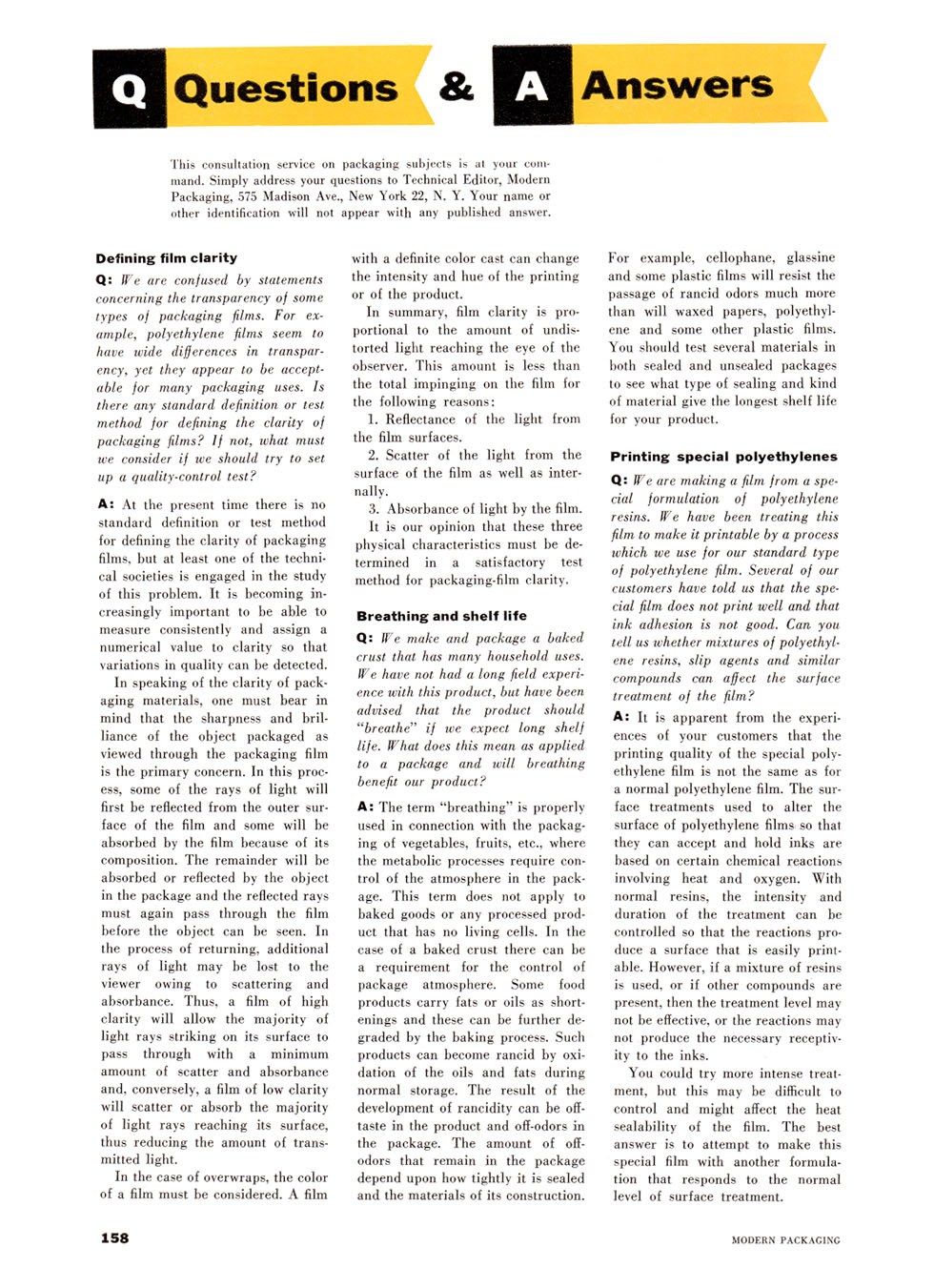


Answers
This consultation service on packaging subjects is at your command. Simply address your questions to Technical Editor, Modern Packaging, 575 Madison Ave., New York 22, N. Y. Your name or other identification will not appear with any published answer.
Defining film clarity
Qt We are confused by statements concerning the transparency of some types of packaging films. For example, polyethylene films seem to have wide differences in transparency, yet they appear to be acceptable for many packaging uses. Is there any standard definition or test method for defining the clarity of packaging films? If not, what must we consider if we should try to set up a quality-control test?
As At the present time there is no standard definition or test method for defining the clarity of packaging films, but at least one of the technical societies is engaged in the study of this problem. It is becoming increasingly important to be able to measure consistently and assign a numerical value to clarity so that variations in quality can be detected.
In speaking of the clarity of packaging materials, one must bear in mind that the sharpness and brilliance of the object packaged as viewed through the packaging film is the primary concern. In this process, some of the rays of light will first be reflected from the outer surface of the film and some will be absorbed by the film because of its composition. The remainder will be absorbed or reflected by the object in the package and the reflected rays must again pass through the film before the object can be seen. In the process of returning, additional rays of light may be lost to the viewer owing to scattering and absorbance. Thus, a film of high clarity will allow the majority of light rays striking on its surface to pass through with a minimum amount of scatter and absorbance and, conversely, a film of low clarity will scatter or absorb the majority of light rays reaching its surface, thus reducing the amount of transmitted light.
In the case of overwraps, the color of a film must be considered. A film
with a definite color cast can change the intensity and hue of the printing or of the product.
In summary, film clarity is proportional to the amount of undistorted light reaching the eye of the observer. This amount is less than the total impinging on the film for the following reasons:
1. Reflectance of the light from the film surfaces.
2. Scatter of the light from the surface of the film as well as internally.
3. Absorbance of light by the film.
It is our opinion that these three
physical characteristics must be determined in a satisfactory test method for packaging-film clarity.
Breathing and shelf life
Q: We make and package a baked crust that has many household uses. We have not had a long field experience with this product, but have been advised that the product should "breathe"ť if we expect long shelf life. What does this mean as applied to a package and will breathing benefit our product?
A: The term "breathing"ť is properly used in connection with the packaging of vegetables, fruits, etc., where the metabolic processes require control of the atmosphere in the package. This term does not apply to baked goods or any processed product that has no living cells. In the case of a baked crust there can be a requirement for the control of package atmosphere. Some food products carry fats or oils as shortenings and these can be further degraded by the baking process. Such products can become rancid by oxidation of the oils and fats during normal storage. The result of the development of rancidity can be off-taste in the product and off-odors in the package. The amount of off-odors that remain in the package depend upon how tightly it is sealed and the materials of its construction.
For example, cellophane, glassine and some plastic films will resist the passage of rancid odors much more than will waxed papers, polyethylene and some other plastic films. You should test several materials in both sealed and unsealed packages to see what type of sealing and kind of material give the longest shelf life for your product.
Printing special polyethylenes
Q' We are making a film from a special formulation of polyethylene resins. We have been treating this film to make it printable by a process which we use for our standard type of polyethylene film. Several of our customers have told us that the special film does not print well and that ink adhesion is not good. Can you tell us whether mixtures of polyethylene resins, slip agents and similar compounds can affect the surface treatment of the film?
A: It is apparent from the experiences of your customers that the printing quality of the special polyethylene film is not the same as for a normal polyethylene film. The surface treatments used to alter the surface of polyethylene films; so that they can accept and hold inks are based on certain chemical reactions involving heat and oxygen. With normal resins, the intensity and duration of the treatment can be controlled so that the reactions produce a surface that is easily printable. However, if a mixture of resins is used, or if other compounds are present, then the treatment level may not be effective, or the reactions may not produce the necessary receptivity to the inks.
You could try more intense treatment, but this may be difficult to control and might affect the heat scalability of the film. The best answer is to attempt to make this special film with another formulation that responds to the normal level of surface treatment.